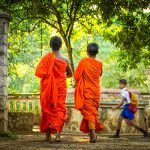The Laureus Foundation, Botham & FOG announce a cutting-edge school and sports centre project for Mankulam
By Michael Roberts
A significant media event was hosted by the Laureus Foundation on the Sunday evening 27th March 2011 at a function room in the Taj Samudra Hotel, Colombo with Sir Ian Botham, Kushil Gunasekera, Muttiah Muralitharan, Kumar Sangakkara, Michael Vaughan and Christopher Martin-Jenkins on the podium. The gathering was meant to publicize a venture that was being launched at Mankulam in the north, one initiated by the Foundation of Goodness, but now supported powerfully by Laureus Sports Foundation.

Botham, Vaughan, Murali, Kushil, Jenkins and a number of foreign journalists had flown to Mankulam by helicopter earlier that day to see the site selected for the project, to look around the devastated war zone and to meet some of the Tamil IDPS who had returned to their locality after the harrowing experiences of war and displacement. This trip in itself was a unique operation calling for permission and cooperation from the army and air force. As such, it was a measure of the influence secured by Kushil Gunasekera and Muralitharan working in conjunction.
As head of the MCC the well-known cricket writer, Christopher Martin-Jenkins started proceedings by indicating that he had recently visited the FOG community project at Seenigama where, a few years preceding, Michael Brearley had inaugurated the MCC Centre of Excellence. He was all praise for the community work that was in place at Seenigama. He said that he was very hopeful that MCC would also be directly involved in the cricketing aspects of the initiative at Mankulam. A fund-raising dinner on June 8, immediately after Sri Lanka’s Test at Lord’s, is planned as a tribute to Muttiah Muralitharan, and MCC will keep close contact with the Foundation for Goodness to ensure that the proceeds go towards a continuing MCC involvement at Mankulam.
Sir Ian Botham marked the central role of the Laureus Sports Foundation in supporting the project of creating a sports village and top-class school at Mankulam by emphasizing the central location of Mankulam, a nodal point which was twenty-thirty miles from other little towns east, west and south and not far from the populated Jaffna Peninsula. He spoke graphically of the flattened and leveled war zone around the place and remarked on the pock-marked and damaged remnants of buildings in the area. He added that he was “hugely impressed by the plans for a new sports complex site which will regenerate communities and encourage reconciliation.”
Muralitharan indicated that the rejuvenation of the war zone and restoration of the life-world of its peoples was an enormous task calling for massive expenditure. The government resources did not stretch in every direction and it was important for private initiatives to fill some of the gaps. They could not go hat in hand to those who had already chipped in to help FOG, so Kushil and he would be seeking new sources of support abroad and had already mapped out visits to USA in the near future. He emphasized that “the army was doing a great job” in assisting the people of Mankulam locality and the north in general, an assessment based on many visits to the former war zone [on top, one could add, of visits during the ceasefire period].
Muralitharan went on to stress that Sri Lanka’s cricket fans were an integral pillar of the success story of cricket in recent years. So it was the duty of cricketers to respond to the needs of supporters who face hardships. Kushil Gunasekera observed that the Mankulam venture was designed to contribute towards a reconciliation of the people of the north and those in the south.
Kumar Sangakkara contended that the Seenigama venture had transformed the locality and was a “fantastic facility.” It was now “a vibrant hub.” As such, the Mankulam project has every prospect of transforming a deprived area. It was at an accessible location and one could envision the development of a “premier sporting facility” in the near future. “We in Colombo,” he said, “were a world away from the war” and not subject to the experiences faced by people in the north and east. This venture was one step towards enabling them “to stand on their own two feet and to become vital members of Sri Lankan society.”
Michael Vaughan stressed that he had been involved in four Laureus projects and in every one of them the response of the children to their visits was uplifting: “their eyes light up.” So his vision was of a future where the Mankulam region would produce a new Sri Lankan cricketer.
Cricketing development is a slow process. In contrast the emergence of local Einsteins in engineering, IT, and other modern professional fields will take less time. The founding of a well-staffed and well-supplied school at Mankulam will bear fruit quickly. Its rejuvenating capacities will be more widespread that those provided by the cricket field. But cricket and sport are fun; and, as fields of joy, a necessary adjunct to academic effort. And, as those on the podium at the Taj Samudra indicated, cricket is an arena that promotes ethnic amity and camaraderie.




